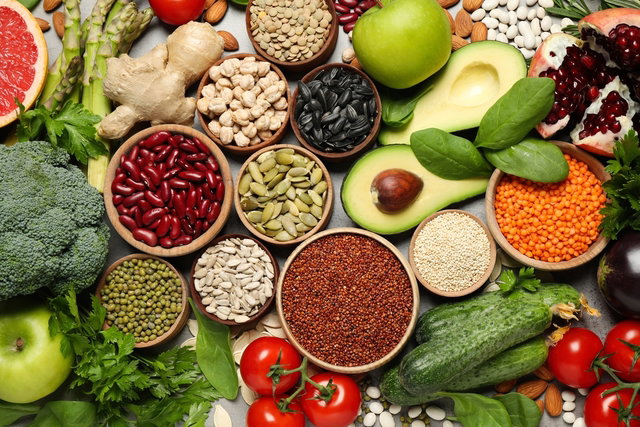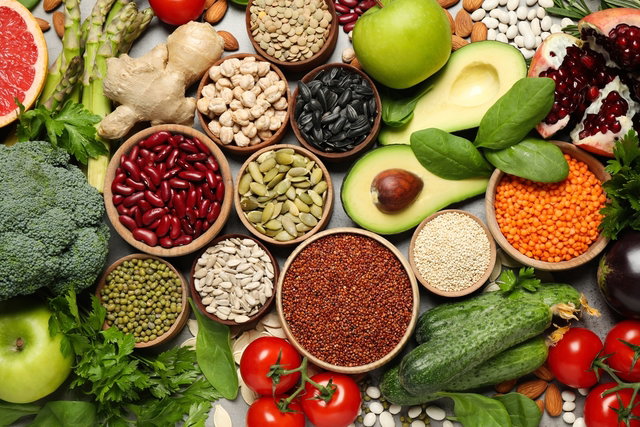Mineral salts are very important nutrients for the body, because they participate in functions such as the production of hormones, the formation of teeth and bones and the regulation of blood pressure.
Mineral salts can be found in foods of plant origin, such as vegetables, fruits and whole grains. Furthermore, foods of animal origin, such as meat, cheese, milk and eggs, also contain mineral salts.
A varied and healthy diet provides adequate amounts of mineral salts for the body. However, some situations such as excessive menstrual bleeding and celiac disease, for example, can cause a deficiency of mineral salts, and in these cases the use of supplements is recommended.

Below we indicate the functions, main sources and recommended quantities for each mineral:
1. Calcium
Calcium is the most abundant mineral in the body, being found mainly in bones and teeth. In addition to the formation of the skeleton, calcium also participates in processes such as muscle relaxation and contraction and the formation of immune system cells.
Where to find: calcium is present in foods of animal origin, such as sardines, milk, cheese and yogurt. But it can also be found in foods of plant origin, such as spinach, beans and tofu. Discover other foods rich in calcium.
Recommended quantity: Calcium intake varies depending on the person’s age and sex. Women aged 51 to 70 need to consume 1200 mg of calcium per day, while men aged 51 to 70 need to consume 1000 mg per day. See the amount of calcium indicated for each age.
2. Ferro
Iron participates in the formation of hemoglobin, which is the component of blood cells responsible for transporting oxygen in the blood.
Furthermore, this mineral also has antioxidant action, inhibiting the formation of free radicals and helping to prevent the emergence of situations such as premature aging, cardiovascular diseases and cancer, for example.
Where to find: iron is found in foods such as beef, chicken, offal and egg yolks. Additionally, iron can also be found in foods of plant origin, such as pumpkin seeds, tofu and nuts. Here’s how to increase your iron intake.
Recommended quantity: The daily amount of iron varies according to the person’s age and sex, with 18 mg of iron per day being recommended for women aged 19 to 50. Men aged 19 to 50 need to consume 8 mg of iron per day.
3. Magnesium
Magnesium participates in processes such as muscle contraction and relaxation, production of vitamin D, balancing blood pressure and cell functions, such as the transport of potassium and calcium.
Furthermore, magnesium also contributes to the production of serotonin and hormones responsible for bone formation, improving mood and helping to prevent osteoporosis.
Where to find: Magnesium is found in various foods, such as seeds, legumes, whole grains, fruits, vegetables, milk and dairy products. See other foods rich in magnesium.
Recommended quantity: Magnesium intake varies depending on the person’s gender and age, where women aged 31 and over need to consume 320 mg per day. Men aged 31 and over should ingest 420 mg of magnesium per day.
4. Phosphorus
Phosphorus helps with the body’s energy metabolism and helps regulate blood pH. Furthermore, phosphorus is also important for the formation and maintenance of healthy bones and teeth.
Where to find: Phosphorus is present in foods such as meat, poultry, eggs, tofu, sardines, milk and dairy products, seeds, legumes and whole grains.
Recommended quantity: The phosphorus recommendation varies according to each person’s age. Children aged 9 to 18 need to ingest 1250 mg of phosphorus per day. Adults aged 19 and over need to consume 700 mg of phosphorus per day.
5. Potassium
Potassium acts in the formation of muscle tissue, muscle contraction and relaxation of arteries, favoring blood pressure control.
Furthermore, potassium helps prevent diabetes, as it improves insulin sensitivity, which is the hormone responsible for balancing blood glucose levels. Discover all the functions of potassium.
Where to find: Potassium is found in many foods, such as whole grains, yogurt, avocados, bananas, milk and potatoes. See a list of foods rich in potassium.
Recommended quantity: Daily potassium intake varies depending on the person’s age and sex, with recommended consumption of 2600 mg per day for women aged 19 and over and 3400 mg for men aged 19 and over.
6. Copper
Copper is a mineral that acts in the formation of melanin, being responsible for the color of eyes, skin, hair and eyes, in addition to being found in the blood, liver, brain, heart and kidney, being important for the formation of red blood cells.
Because it has antioxidant action, copper also protects the body against free radicals, preventing situations such as premature aging, flu and colds.
Where to find: The main foods rich in copper are legumes, nuts, meat and seafood. Furthermore, copper can also be found in vegetable oils, eggs, fruits and vegetables. Discover other foods that are sources of copper.
Recommended quantity: The copper recommendation varies according to each person’s age. Children aged 14 to 18 need to consume 890 mcg of copper per day, while adults aged 19 and over need to consume 900 mcg of copper daily.
7. Sodium
Sodium helps control blood pressure, regulate fluid levels in the body and blood pH, in addition to participating in the absorption of nutrients, the transmission of nerve impulses and muscle contraction.
Where to find: The main source of sodium is table salt, but this mineral is also present in cheese, seaweed, sausages, pickled vegetables, milk and eggs. See other foods rich in sodium.
Recommended quantity: Sodium intake varies depending on each person’s age, with consumption of 1200 mg being recommended for children aged 9 to 13 years. For adults, the recommended sodium intake is 1500 mg per day.
8. Chrome
Chromium is an important mineral for improving the functions of the hormone insulin, promoting control of blood glucose levels, as well as helping with the absorption of nutrients such as carbohydrates, proteins and fats. Learn more about the functions of Chrome.
Where to find: Chromium can be found in various foods, such as whole grains, meats, breads, brewer’s yeast, oilseeds and spices.
Recommended quantity: The recommended intake of chromium per day is just 25 mcg for women between the ages of 31 and 50. For men aged 31 and 50, the recommended amount of chromium is 35 mcg.
9. Iodine
Iodine participates in the formation of T3 and T4 hormones in the thyroid, which are involved in the growth and development of the bones, nervous system and brain of the fetus during pregnancy, in addition to helping to prevent diseases such as hyperthyroidism and goiter.
Where to find: The main sources of iodine are marine foods, such as algae, seafood, fish, such as tuna, cod and salmon, as well as being present in dairy products and iodized table salt. See a list of foods rich in iodine.
Recommended quantity: The iodine recommendation varies according to the age of each person, with an intake of 120 mcg per day being recommended for children aged 9 to 13 years. For people aged 14 and over, iodine consumption should be 150 mcg per day.
10. Zinc
Zinc is important for the growth of the fetus, children and adolescents. In addition, zinc also has antioxidant and anti-inflammatory actions, strengthening the immune system, thus helping to fight viruses and bacteria and improving wound healing.
Where to find: Zinc can be found in foods such as oysters, shrimp, beef, chicken, fish and offal. Discover other foods that are sources of zinc.
Recommended quantity: The recommended amount of zinc varies according to each person’s gender and age. Children ages 4 to 8 need to consume 8 mg of zinc per day. The zinc recommendation for people aged 14 and over is 11 mg per day.
11. Selenium
Selenium has great antioxidant power and, therefore, fights free radicals and improves the functions of the immune system, which can help prevent cardiovascular diseases and cancer, for example. Discover all the functions of selenium.
Where to find: selenium is present in foods such as Brazil nuts, sunflower seeds, wheat flour, bread and egg yolks.
Recommended quantity: The daily intake of selenium varies depending on the age of each person, with consumption of 55 mcg per day being recommended for people over 14 years of age.
12. Fluoride
The main function of fluoride in the body is to prevent the loss of minerals through the teeth and prevent the onset or advancement of cavities. Furthermore, fluoride also helps in the formation and maintenance of bone health.
Where to find: Fluoride is added to drinking water and toothpastes, and can also be applied by the dentist in the office. Additionally, fluoride is also found in small amounts in foods such as coffee, shrimp and black tea.
Recommended quantity: adequate fluoride intake per day is very little. Men over the age of 19 need to consume 4 mg of fluoride per day, while the recommendation for women aged 19 and over is 3 mg per day.
When to take mineral salt supplements
The use of supplements should be indicated in cases of low consumption of foods that are sources of mineral salts.
Furthermore, these supplements can also be indicated in situations that require greater amounts of mineral salts, such as osteoporosis, kidney failure, excessive menstrual bleeding, Crohn’s disease and celiac disease, for example.
The type and quantity of supplements varies according to each person’s health status, age and sex. Therefore, the use of mineral salt supplements should only be used under the advice of a doctor or nutritionist.

Sign up for our newsletter and stay up to date with exclusive news
that can transform your routine!
Warning: Undefined array key "title" in /home/storelat/public_html/wp-content/plugins/link-whisper-premium/templates/frontend/related-posts.php on line 12
Warning: Undefined array key "title_tag" in /home/storelat/public_html/wp-content/plugins/link-whisper-premium/templates/frontend/related-posts.php on line 13




